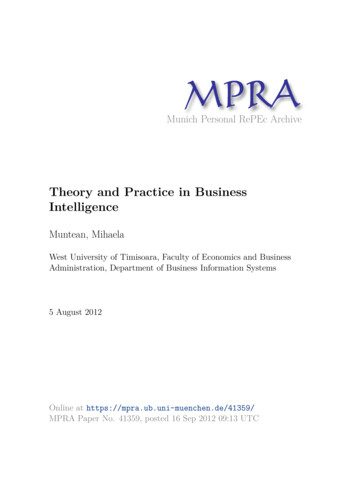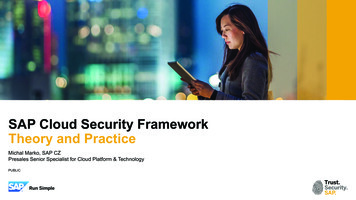
Transcription
Munich Personal RePEc ArchiveTheory and Practice in BusinessIntelligenceMuntean, MihaelaWest University of Timisoara, Faculty of Economics and BusinessAdministration, Department of Business Information Systems5 August 2012Online at https://mpra.ub.uni-muenchen.de/41359/MPRA Paper No. 41359, posted 16 Sep 2012 09:13 UTC
Theory and Practice in Business IntelligenceMIHAELA I. MUNTEANDepartment of Business Information SystemsWest University of Timisoara, Faculty of Economics and Business Administration16, H. Pestalozzi St., 300115, t: - The debate is developed based on the following considerations: 1 - Business Intelligence (BI) isunanimous considered the art of gaining business advantage from data; therefore BI systems and infrastructuresmust integrate disparate data sources into a single coherent framework for real-time reporting and detailedanalysis within the extended enterprise; 2 - Business Intelligence can be described as a value proposition thathelps organizations in their decision-making processes; 3 – the Business Intelligence Value Chain represents a„From DATA To PROFIT“ approach and is recommended to ground any performance management program.Different aspects, including theoretical considerations and practice examples, regarding location intelligence,mobile BI, cloud-based BI, social BI and collaborative Business Intelligence will be treated, pointing out someof the author’s contributions.Nowadays, organizations have adopted more prudent policies requiring a financial justification for nearly everyIT initiative, including Business Intelligence system implementations. A business-driven methodology isrecommended in any BI project management approach, project scoping and planning being vital for the projectsuccess. A business-driven approach of a BI project implementation starts with a feasibility study. Thedecision-making process for large projects is very complicated, and will not be subject of this paper. Having inmind a middle-sized BI project, a feasibility study based on the Monte Carlo simulation method will beconducted.Key-Words: - Business Intelligence (BI), BI value chain, BI project, Location Intelligence, Social BI,Mobile BI, Cloud BI, Collaborative BI1 Bringing Together BI Concepts„Business Intelligence“ is an umbrella term forvarious business managing approaches based onwell-informed decisions, which lead to a highperformance level within organizations(Brohman, D.K., 2000; McKnigts, W., 2004;Melfert, F., Winter, R., Klesse, M., 2004; Mukles,Z., 2009; Hatch D., Lock M., 2009; Borysowich,C., 2010; Jamaludin, I. A., Mansor, Z., 2011;Mircea M. (ed.), 2012).Only optimizing performance a company cansurvive and remain a competitor in a changingmarket, being flexible to new demands(Muntean, M., Cabău, L., 2011). Corporate datarepresents a valuable asset, total indispensablefor decision makers.DEFINITION (D1): Business Intelligence (BI)can be defined as the art of gaining businessadvantage from data.Fig 1. D1.Business IntelligenceCorporate data, like customer information,supply chain information, personnel data,manufacturing data, sales and marketingactivity data as well as any other source ofcritical information, need to be brought togetherinto a single coherent framework for real-timereporting and detailed analysis within the
(extended) enterprise. With the help of a BIapproach, data is transformed into a high-valueinsight.DEFINITION (D2): Business Intelligence (BI)can be described as a value proposition thathelps organizations in their decision-makingprocesses (Muntean, M., 2012).Fig. 2 D2.Business IntelligenceAccording to Porter, M. E. (1980), a valuechain is a systematic approach to examine thedevelopment of competitive advantage,consisting of a series of activities that createand build value. All the stages and relationshipsin this approach will add value to the decisionsupport process. Based on the introduced valuechain, tasks like Business Analysis, EnterpriseReporting and Performance Management arepossible.DEFINITION (D3): The BI Value Chainrepresents a „From DATA To PROFIT“approach and is recommended to ground anyperformance management program (Muntean,M., Cabău, L., 2011).Fig. 3. D3.Business IntelligenceBusiness data is transformed into relevant anduseful information. Further, the obtainedvaluable knowledge supports any decisionmaking processes in order to achieve profit.Succesful BI initiatives are possible with thesupport of technologies, tools and systems thatare capable to sustain the introduced valuechain.DEFINITION (D4): BI Systems, based on dataaggregation, analysis, and reporting capabilities,are tools that facilitate all kind of businessanalysis, relevant enterprise reporting andperformance management specific tasks.DEFINITION (D5): BI Architecture (BIA) is aconcept that corespond to the approachintroduced in Figure 2, decribing also the mainfuntionalities of any BI tool.IT professionals, develop BI approaches on the„Data Warehouse Environment” concept,supposing the BI value chain (Inmon, W. H.,2000; Borysowich, C., 2010).DEFINITION (D6): A Data WarehouseEnvironment (DWE) is considered to consist offour main elements: 1 - source systems: theyprovide the raw material for the data warehouseand business intelligence systems; 2 extraction, transformation and load systems; 3 data warehouse repository: most are built onrelational database management systems andadvanced users combine them with OLAPsystems as well; 4 - reporting tools and portals.Despite the dominant technological perspectiveincluded in D6, business performance is notneglected.Analyzing the BI market at the end of 2011, keyforces like cloud, mobile, social and big datawill play key role in future BI initiatives. Basedon the fact that most of the data (80% of thedata) stored in corporate databases has a spatialcomponent, a Business Intelligence approachfor spatial enablement is recommended to bedeveloped (IDC, 2011).DEFINITION (D7): Location Intelligence (LI)is the capacity to support spatial data and tomap geographic contexts to business data.The spatial effect will be having consequencesalong the whole BI value chain; technologyshould be able to model this behaviour (Figure4). Spatial BI has become a top priority fororganizations of all sizes and industries that areseeking location-based insight, either to gain acompetitive edge, improve organizationalperformance management or both.The popularity of mobile devices conducted tothe spread of the BI mobile phenomena.DEFINITION (D8): Mobile BI is the ability toplace reporting and analytics in the hands ofdecision-makers, wherever they are via theirmobile devices.According to Dresner Advisory (2012) the iPad
has been identified as a dominant platform forMobile BI.on a mobile device); 3 - Mobile BI created withGraphical Development Tools.Software as a Service (SaaS) is a model ofsoftware delivery that allows companies todeliver solutions to its customers in a hostedenvironment over the Internet (Joha A., JanssenM., 2012). All major analysts, including IDC,Garnter, and Forrester, predict for the SaaS BImarket a major growth through 2013 (Neubarth,M., 2011). Nowadays, various Cloud BIinitiatives, in fact SaaS approaches, are gainingadvantage over the traditional ones, lower costsbeing the main reason for this phenomena(Reyes, E.P.,2010).DEFINITION (D9): Cloud-Based BI is a BIsoftware solution that runs in the cloud and isaccessible via any web browser in a so-calledSaaS model.Fig. 5 D9. Cload-Based BI (Reyes, E.P., 2010)Fig. 4 D7. Location Intelligence. Spatial BI(Badard, T., Dube, E., 2010)Commonly, using IBM Business Intelligencemobile apps for Apple, BlackBerry andAndroid, decision-makers can interact withreports, analysis, dashboards and more on smartphones, tablets and notebook computers.Similar, Microsoft's mobile BI support strategyfor the Apple iPad inched forward slightly forthose using SharePoint 2010. More than 33% ofBI functionality will be consumed via handhelddevices by 2013 (Gartner, 2011). Threeapproaches have been identified: 1 - Devicespecific BI applications; 2 - Mobile Interfacesto Existing BI platforms (many companiesexpand their existing BI platforms with theability to display fixed-form business data –charts or tables – through a BI client installedAccording to D9, Cloud-Based BI is the fulloffer of the cloud computing provider. But, asshown in Figure 5, two subset variants are alsopossible: Cloud Platform as a Service (PaaS);Cloud Infrastructure as a Service (IaaS).As social networking has becoming a popularenvironment, also an enabler for businesses tointerface with the public in new ways, decisionmakers found it useful to take into considerationconsumer feedbacks send via these socialmedia.DEFINITION (D10): Social BI is the process ofcollecting social data, analyzing it in order tomake better decisions.A theoretical approach is subject of (Muntean,M., 2012), concrete implementation details willbe subject of a future debate (Muntean, M.,Cabau, L, 2012). New ways of collecting andanalyzing social data are being discovered asquickly as new software and technologiesgalvanize the imagination of the public. Still
business executives and business analysts wantto ensure that the feedback data they incorporateinto critical decisions is of comparable qualityto the internal data they've been using.Beyond analyzing feedbacks and seeking foradvice, companies are interested to develop acollaborative environment to ensure thatdecisions made have consensus at approval atthe same time.DEFINITION (D11): Collaborative BI (CBI) Location Intelligence Social BI (eithertraditional BI or SaaS BI/Cloud BI);additionally mobile features.the new extended approach (Muntean, M.,Cabău, L., 2012).Also the solution to a business problem is aprocess that includes business intelligence, BI,by itself, is rarely the complete solution to theproblem. Therefore, BI tools must understandthe process and how to be part of it.Fig. 6 PE1. Data warehouse proposal(Muntean, M., Târnăveanu, D., Paul, A., 2010)2 Practice Examples2.1 Establishing the DW ArchitectureIt is obvious that, establishing a proper DataWarehouse (DW) architecture is a good start forany BI approach (McKnights, W., 2004). Theefficacy of having a centralized data store withquality,integrated,accessible,highperformance and scalable data can’t be denied,but short term business needs can conduct to adata mart oriented BI solution. DWs are not aonce off implementation; they are amedium/long term investment (Cope, D., 2007).PRACTICE EXAMPLE (PE1): One of theauthor’s contributions represents a BI systemproposal capable to monitor and count the webtraffic from both the visitor prospective, as wellas from the website prospective. The DWproposal (Figure 6) sustains the whole BIapproach presented in (Muntean M.,Târnăveanu, D., Paul, A., 2010).PRACTICE EXAMPLE (PE2): As Social BIbecomes quit a phenomena, a conceptualschema for a DW proposal was subject of aresearch demarche (Muntean, M., 2012). Thesocial perspective represents in fact an add-onof a traditional BI system (Figure 7). Theintegration of the social view into a classical BIschema is possible by transforming a fact tableof the traditional BI model into a dimension ofFig. 7 PE2. Data warehouse proposal(Muntean, M., Cabău, L., 2012)
2.2 BI Reporting. Introducing QR CodesDespite their usage in advertising and on-lineshopping, Quick Response (QR) codes can beplaced in BI reports, for example associatedwith some totals/subtotals of the displayeddetail information.PRACTICE EXAMPLE (PE3): A BI toolproposal for monitoring the total sales evolutionwas subject of (Muntean, M., Mircea, G.,Băzăvan, S., 2012). The report in Figure 8contains relevant information for analyzing theperformance of the sales agents.2.3 Evaluating a BI initiativeThe theoretical approach of this researchdemarche is subject of an author’s currentworking paper (Muntean, M., Muntean, C.,2012). Without any doubts, a rigorouslyfeasibility analysis should be performed beforestarting any BI initiative.The in (Muntean, M., Muntean, C., 2012)introduced general framework appeals to theMonte Carlo simulation techniques fordeploying pessimistic, probable and optimisticscenarios.PRACTICE EXAMPLE (PE4): A feasibilityanalysis for a middle-sized BI project has heoreticaldesigneddemarche. With the help of a popular MonteCarlo simulation based tool, predictions for theinputs have been established, results (likeReturn of Investment (ROI) and Internal Rate ofReturn (IRR)) have been analyzed (Figure 9).Fig. 8 PE3. From data warehouse to reporting(Muntean, M., Mircea, G., Băzăvan, S., 2012)Fig. 9 PE4. BI initiative. Feasibility analysis based on Monte Carlo method(Muntean, M., Muntean, C., 2012)
3 Conclusions and Future WorkBased on a selective literature review and someof the author’s recent papers, a unifyingtheoretical approach of the most relevantBusiness Intelligence specific concepts has beeninitiated. The eleven introduced definitions (D1D11) are describing the actual BI phenomena,establishing the domain coordinates.Based on these considerations, four practiceexamples (PE1-PE4) have been introduced,closing the gap between theory and practice.Data warehouse proposals, an innovative use ofQR codes in BI reporting and a feasibilityanalysis for BI initiatives are the debate subject.Detailed implementation aspects have beentreated by the author in the indicated references,and further research perspectives areestablished: 1 - finalizing an implementation ofthe data warehouse model presented in Figure 7(BI social); 2 – going deeper with QR codes inBI mobile; and 3 – applying the Monte Carlomethod in further BI project initiatives, projectmanagement approaches.References:[1] Badard, T., Dube, E., Spatial BusinessIntelligence, GeoSOA research groupWhite Paper, 2010[2] Borysowich, C., Tuning the Data Warehousehttp://it.toolbox.com/blo
Theory and Practice in Business Intelligence Muntean, Mihaela West University of Timisoara, Faculty of Economics and Business Administration, Department of Business Information Systems 5 August 2012 Online at https://mpra.ub.uni-muenchen.de/41359/ MPRA Paper No. 41359, posted 16 Sep 2012 09:13 UTC. Theory and Practice in Business Intelligence MIHAELA I. MUNTEAN Department of Business .











